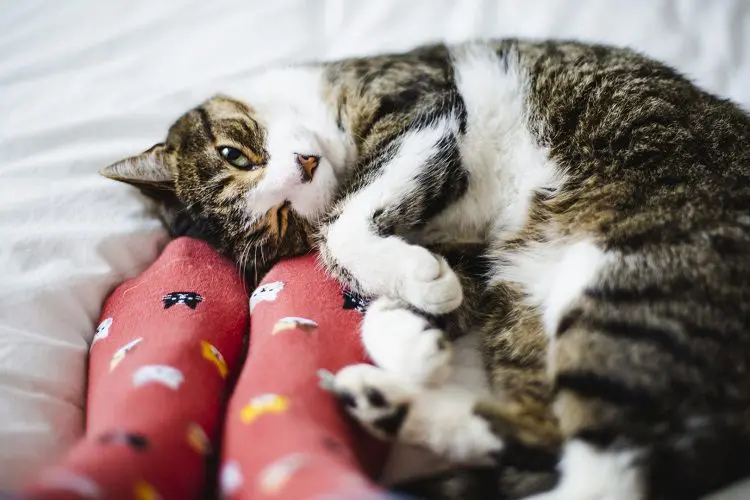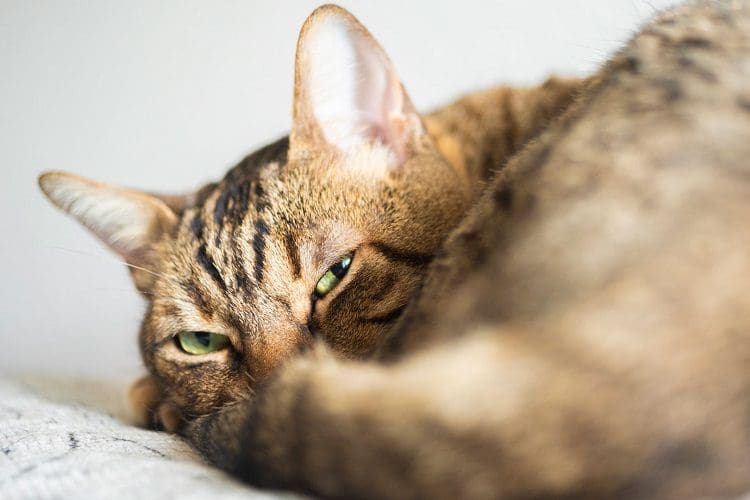Last Updated: 1 week ago
Well, the answer is yes! Cats are beloved companions, but their bodies and behavior can sometimes be a mystery to us.
A cat’s heat cycle consists of four stages that include signs like increased vocalization and affection-seeking behaviors.
Knowing how to care for your cat during her heat cycle is essential to keeping them healthy and happy throughout this time.
We’ll discuss spaying or neutering as well as other common questions about cats’ reproductive health so that you can make sure your feline friend has everything they need when it comes to their period cycles!
What is a Cat’s Heat Cycle?

A cat’s heat cycle is a period of time when female cats become sexually receptive and ready to mate.
During this time, the female cat will display certain behaviors that are associated with being in heat.
It’s important for pet owners to understand what happens during a cat’s heat cycle so they can provide proper care and attention for their feline companion.
What Happens During a Cat’s Heat Cycle?
During a cat’s heat cycle, her body begins producing hormones that cause physical changes such as increased appetite, restlessness, vocalization (meowing), rubbing against objects or people, rolling on the floor, and spraying urine around the house.
She may also exhibit signs of aggression towards other cats or animals in the home due to hormonal changes. The most obvious sign of being in heat is when she starts calling out for male cats by yowling loudly and persistently.
How Long Does a Cat’s Heat Cycle Last?
The length of each individual cat’s heat cycle varies but typically lasts between 7 and 10 days, with some lasting up to 14 days depending on breed and age.
Cats usually go into their first estrus (heat) at 6 months old, but it can vary from 4 to 12 months depending on breed size and genetics.
After her first estrus, she will enter another one every 2–3 weeks until she is spayed or bred successfully.
Do Cats Have Periods?

Cats do not have periods like humans, but they do experience a heat cycle.
The difference between a cat’s heat cycle and menstruation is that cats are induced ovulators, meaning that the female does not release an egg until she has been stimulated by a male.
This is why it’s important to spay or neuter your pet if you don’t plan on breeding them.
Do female cats bleed during their heat cycles?
Yes, some female cats may experience light bleeding during their heat cycles. However, this is usually only for one or two days and should not be confused with menstruation, as it does not happen every month like in humans.
Generally speaking, no; however, unspayed females can be at risk of developing uterine infections due to prolonged exposure to male hormones during a season, which can lead to serious medical issues if left untreated.
Additionally, unspayed females are more likely to roam and become pregnant, which can also lead to complications such as birthing difficulties or even the death of the mother or kittens if proper care isn’t taken throughout the pregnancy process.
Therefore, it is best practice for all pet owners who do not plan on breeding their animals to get them spayed/neutered as soon as possible in order to keep them safe from the potential risks associated with being in season regularly.
Cats have heat cycles instead of periods, and it is important to understand the difference between the two in order to properly care for your cat. The next section will provide tips on how to make sure your cat stays comfortable during her heat cycle.
Do All Female Cats Go Into Heat?

Yes, all female cats go into heat. A cat’s heat cycle is a period of time when she is fertile and can become pregnant. The average heat cycle lasts between 7 and 10 days but can vary from cat to cat.
During this time, the female will display certain behaviors, such as increased vocalization, rolling around on the floor, and rubbing against objects or people in an attempt to attract males.
Can Male Cats Get Fixed Too?
Yes. Neutering male cats is just as important as spaying females for population control and health reasons. Neutering involves surgically removing a male cat’s testicles so that it cannot reproduce.
It also helps reduce aggressive behavior and spraying by decreasing testosterone levels in the body.
Most veterinarians recommend neutering your male kitten before he reaches 6 months of age for the best results.
Do cats have periods every month?

No, cats do not have periods every month. Female cats (queens) will go into heat approximately every two to three weeks and can remain in heat for up to a week.
During this time, they may display behaviors such as increased vocalization, restlessness, or rubbing against objects.
However, these temperatures are not the same as menstruation in humans, and no blood is released from the cat’s body during this period of time.
How do I know if my cat got her period?
Female cats typically reach sexual maturity between 5 and 9 months of age. Signs that your cat is in heat include increased vocalization, restlessness, rolling around on the floor, and rubbing against objects.
If you notice any of these behaviors, it’s likely that your cat has entered her reproductive cycle. Additionally, she may have a bloody discharge from her vulva which indicates she has started her period.
It’s important to keep an eye on your cat during this time as she may become more prone to wandering or fighting with other cats if not spayed soon after entering into heat.
How often do cats have periods?
Cats do not have periods in the same way that humans do. Female cats go into heat, which is a period of time when they are receptive to mating and become more vocal and affectionate.
This typically occurs every two to three weeks during the spring and summer months, although some cats may cycle more frequently or less often depending on their age and environment.
During this time, female cats will also display signs of increased activity such as roaming around outdoors or pacing inside the house.
Symptoms of a Cat in Heat

Symptoms of a cat in heat can be confusing for a first time cat owner.
When a cat goes into heat, she can act quite unlike the kitty her owner has gotten used to, which can be disconcerting if the owner doesn’t know what’s going on.
Knowing the symptoms of a heat can help you determine if your cat is sick or just heading into her cycle.
#1 Vocalization
This is where some people think that their cat is in distress. When a cat goes into heat she becomes very vocal.
She will stalk the house mewling and yowling and generally causing an ear-piercing uproar. This is totally normal.
She’s not in pain. She’s announcing to any male cat within ear shot that she’s ready to make some kittens.
#2 Facial Marking
Excessive facial marking is another of the common symptoms of a cat in heat. Your cat will rub her face on any and everything – including you.
You might think she’s being super cuddly, but what she’s actually doing is scent marking you along with everything else in the house to ensure that any male cat in the area can find her.
#3 Lordosis Position
People who have never seen a cat in heat often mistake this position as just another weird thing a cat does when she’s playing, but the lordosis position is actually the stance she takes for mating with a tomcat.
She’ll rest her chest on the ground and stick her rump up into the air, keeping her tail up or over and out of the way of her genitals.
This is an innate instinct and can happen at almost any time but scratching the base of her tail can cause her to immediately assume the position. So maybe stick to scratching her ears until it’s over.
#4 Some Bleeding
When a cat is in heat, you can expect to see a small amount of bleeding from her vaginal area.
This is perfectly natural and nothing to be concerned about.
How to Care for Your Cat During Her Heat Cycle

Caring for your cat during her heat cycle can be a challenging time, but it is important to provide the best care possible.
It’s important to make sure that your cat has plenty of space away from other cats or animals in the house during her heat cycle.
Provide extra bedding, blankets, or towels so she can stay warm and comfortable as she goes through this period of discomfort.
Additionally, if you have multiple cats in the household try separating them into different rooms with their own litter boxes so they don’t fight over territory.
Cats may become more anxious during their heat cycles due to increased hormones which can lead to behavioral issues such as excessive meowing or scratching furniture.
To help reduce stress levels, create a calm environment by playing soothing music or providing toys that will distract her from any anxiety-inducing situations like loud noises outside or visitors coming into the house.
You should also spend quality time with your cat every day by petting her and talking softly – this will help build trust between you two and create an overall calming atmosphere for both of you.
As cats go through their heat cycles they tend to produce more pheromones which can cause strong odors throughout the house if not taken care of properly.
To help keep your home clean and odor free, make sure that all litter boxes are cleaned regularly (at least once a day) using an unscented clumping litter – this will help absorb any unpleasant smells quickly before they spread around the entire house.
Additionally, use air fresheners sparingly as too much fragrance could irritate sensitive noses (both yours and hers). Finally, open windows when possible so fresh air circulates throughout the home; this helps clear out any lingering odors quickly.
Spaying and Neutering Cats

Spaying and neutering cats is an important part of responsible pet ownership.
Not only does it help reduce the number of homeless animals, but it also has many health benefits for your cat.
Benefits of Spaying or Neutering Your Cat
By spaying or neutering your cat, you can help prevent unwanted litters and decrease the risk of certain cancers in cats such as uterine cancer and testicular cancer.
Additionally, spayed female cats are less likely to roam away from home in search of a mate, which can be dangerous for them if they end up on the streets.
Neutered male cats are also less likely to spray urine around the house to mark their territory.
When Should You Spay or Neuter Your Cat?
It’s recommended that you spay or neuter your cat when they reach sexual maturity at around 6 months old (or earlier).
This will ensure that they don’t have any kittens before they’re ready to handle motherhood responsibly.
However, some veterinarians may recommend waiting until your cat is older than 6 months depending on their breed and size.
Spaying and neutering cats can help keep them healthy and reduce their risk of developing reproductive health issues.
Conclusion
In conclusion, cats do not have periods as humans do. However, they go through a heat cycle which is their way of preparing for reproduction.
During this time, it’s important to be aware of the signs and provide your cat with extra care and attention.
Spaying or neutering your cat can help prevent unwanted pregnancies as well as reduce the risk of certain health issues in cats.
If you have any questions about whether or not “do cats have periods” or other reproductive health concerns for your pet, please contact your veterinarian for more information.
Resources:

Olfa knows how to get things done and has a keen business sense that others admire. She’s always on the go, coming up with new ideas! Her ability to anticipate the needs of her readers and deliver information that they want is what makes CatVills such a success. She loves cuddling her cat Picaciu. He is her inspiration.
